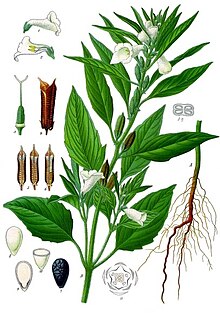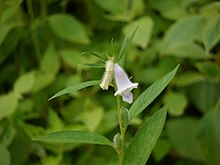sesame
| sesame | ||||||||||||
|---|---|---|---|---|---|---|---|---|---|---|---|---|

Sesame ( Sesamum indicum ) |
||||||||||||
| Systematics | ||||||||||||
|
||||||||||||
| Scientific name | ||||||||||||
| Sesamum indicum | ||||||||||||
| L. |
Sesame ( Sesamum indicum ) is a flowering plant from the family of pedaliaceae (Pedaliaceae). It is a widespread crop and is believed to be one of the oldest oil plants in the world.
Word origin
The word "sesame" was borrowed into German in the 16th century at the latest from the Latin sēsamum and similar forms, which had been taken over from ancient Greek σήσαμον sēsamon and similar forms, where they probably came from a Semitic language.
description
Sesame is an annual , herbaceous plant that reaches heights of 10 to 120, rarely up to 180 centimeters, and is branched or unbranched. The stems are bluntly square, furrowed and glabrous to finely haired and often covered with glands.
The very variable, glandular and finely hairy leaves are arranged opposite or alternate. The lower leaves are ovate to ovate-lanceolate, pinnate in three parts or lobed, 4 to 20 centimeters long, 2 to 10 centimeters wide, rounded to blunt at the base, tapering to a point and serrated on the edge. The leaf stalks are 3 to 11 inches long. The upper leaves are short-stalked, 0.5 to 3 centimeters in length. With a width of 0.5 to 2.5 centimeters, the upper leaves are slimmer, with entire margins and oblong-lanceolate to linear-lanceolate.
The flowers are white, pink or pink with dark markings. The calyx is permanent, the hairy calyx lobes are elongated and 2 to 5 millimeters long. The crown is 1.5 to 3.3 centimeters long, the stamens glabrous. The anthers are 2 to 3 millimeters long. The ovary is 1 to 1.5 millimeters long and hairy, the fruit is an oblong, square, finely hairy and glandular capsule , 1.5 to 3.2 centimeters long and 6 to 7 millimeters wide, rounded at the base and tip . The seeds are 2.5 to 3 millimeters long and 1.5 millimeters wide, in color from black, brown, yellowish to white.
The number of chromosomes is 2n = 26.
distribution
Sesame is originally native to parts of India. Today it is grown in tropical and subtropical areas around the world.
history
The cultivated sesame comes from wild plants in South Asia , especially from the Malabar Coast , northwestern India and Pakistani Punjab . These original wild varieties are called Sesamum malabaricum or S. mulayanum . Sesame was found in layers of the 3rd millennium BC at sites of the Indus culture . Archaeologically proven. Finds in Mesopotamia provided evidence of sesame seeds before 2000 BC. In the course of the 2nd millennium, sesame had spread across large parts of India. Assumptions that there was sesame in Africa early on have not been confirmed. Ancient Egyptian finds are doubtful, sesame in Egypt during the Greek period (4th – 1st century BC) is considered probable. The earliest traces of sesame further south in Africa were found in the Nubian town of Qasr Ibrim between 300 and 500 AD. Otherwise, the plant seems to have only been found in Africa since very recently.
use
The seeds, the oil and the root of the sesame are used for therapeutic and culinary purposes. The oil-rich seeds of sesame are processed into sesame oil , which is mainly used for cooking - pressed from roasted seeds, it is also used as a seasoning ingredient (e.g. Gomashio (Japanese) / Kkaesogeum (Korean)). The whole seeds are used - often roasted - to refine baked goods and to season dishes. Sesame is one of the foods richest in selenium (800 µg / 100 g). In addition, sesame seeds contain a considerable amount of calcium with over 700 mg per 100 g . Sesame is a strong allergen and must be specified as a declarable allergen for processed foods in the list of ingredients, even in the smallest quantities.
Other uses:
- Halva , a confectionery that uses sesame seeds as an ingredient
- Tahina , a paste made from ground sesame seeds in Arabic cuisine and an important component of hummus
- Sesame bars, a handy snack for which whole sesame seeds are processed with honey or sugar
The fatty oil obtained from the ripe seeds by cold pressing or extraction and subsequent refining is used as a remedy. The active ingredients are oleic acid and linoleic acid , as well as palmitic acid , stearic acid , lignans , sesamin , sesamolin , sterols .
Sesame oil is used pharmaceutically in ointments . It makes it easier to remove scabs and crusts and has general nourishing properties for dry skin. In injection solutions, it is used as a solvent for liposoluble drugs. Sesamol , which is contained in traces, has a synergetic effect in insect control agents together with pyrethrum .
The "sesame leaves" (깻닢) used in Korean cuisine to wrap bulgogi , galbi or samgyeopsal are not leaves of the sesame plant, but of the perilla plant , which is also known as "wild sesame" because of the similar leaf shape.
Average composition
Per 100 g of edible portion:
|
|
|
|
Economical meaning
According to the food and agriculture organization FAO, 6,015,575 t of sesame seeds were harvested worldwide in 2018.
The following table gives an overview of the ten largest producers of sesame seeds worldwide, who produced a total of 83.0% of the harvest.
| rank | country | Quantity (in t ) |
|---|---|---|
| 1 |
|
981,000 |
| 2 |
|
768.858 |
| 3 |
|
746,000 |
| 4th |
|
572,761 |
| 5 |
|
561.103 |
| 6th |
|
431,500 |
| 7th |
|
301,302 |
| 8th |
|
253.936 |
| 9 |
|
206,522 |
| 10 |
|
172,539 |
| remaining countries | 1,020,054 |
literature
- E.A. Bruce: Pedaliaceae . In: Flora of Tropical East Africa . 1953.
- Gernot Katzer: Sesame (Sesamum indicum L.). In: Gernot Katzer's spice pages. Retrieved on September 21, 2017 (also with a lot of additional etymological information).
- Ingrid and Peter Schönfelder : The new book of medicinal plants. Franckh-Kosmos, Stuttgart 2011, ISBN 978-3-440-12932-6
Web links
Individual evidence
- ↑ Sesame. In: Jacob Grimm , Wilhelm Grimm (Hrsg.): German dictionary . 16 volumes in 32 sub-volumes, 1854–1960. S. Hirzel, Leipzig ( woerterbuchnetz.de ).
- ↑ Sesame, the. In: Digital dictionary of the German language . Retrieved September 21, 2017
- ↑ Douglas Harper: sesame (n.). In: Online Etymology Dictionary. Accessed on September 21, 2017 (English, further etymological information).
- ↑ Sesamum indicum at Tropicos.org. In: IPCN Chromosome Reports . Missouri Botanical Garden, St. Louis
- ^ DQ Fuller: Further Evidence of the Prehistory of Sesame. (PDF; 576 kB) In: Asian Agri-History , Volume 7, No. 2, 2003, pp. 127-137.
- ↑ ernaehrung.de
- ↑ Rhinitis sicca - nasal care with sesame oil. ( Memento of January 17, 2013 in the Internet Archive ) PTA.
- ↑ German Research Institute for Food Chemistry, Garching (ed.): Food table for practice . The little souci · specialist herb. 4th edition. Wissenschaftliche Verlagsgesellschaft mbH, Stuttgart 2009, ISBN 978-3-8047-2541-6 , p. 329 .
- ↑ Crops> Sesame seed. In: Official FAO production statistics for 2018. fao.org, accessed on May 9, 2020 .






